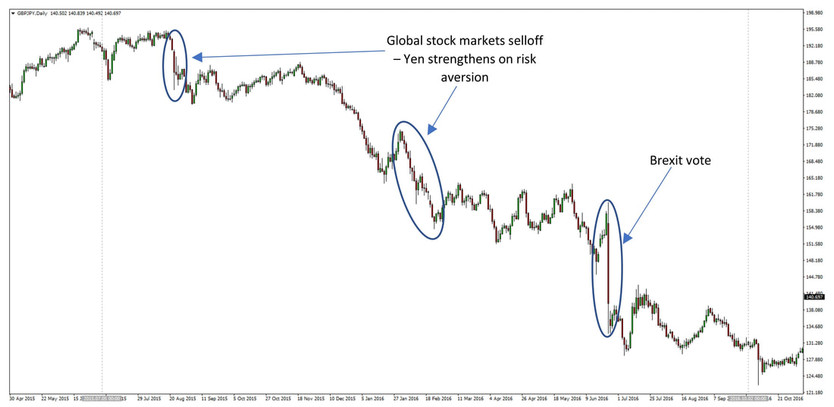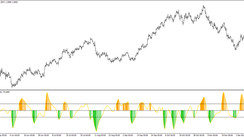Fundamental strategies to position on the crosses
As was indicated in the previous articles of this series, if we take a larger group of currencies, like for example the 8 majors, normally there will be a natural rotation between which one is the strongest and which one is the weakest currency during different time periods.
This holds true both in the short and the long term, so, for example, one day, the US Dollar will be the strongest currency while the Euro will be the weakest on the day, and on another day the British Pound may outperform all while the Euro and the US Dollar will fall somewhere in between.
Similarly, over a longer period, like 6 - 12 months, 1 currency may outperform all the other and hence we say it’s the strongest currency for that specific period. These kinds of larger moves in the forex market are driven by fundamentals, hence it's important for currency traders to be aware of the main Forex fundamental factors.
In this article, we describe some fundamental strategies and factors that are helpful in spotting major Forex trends.
Expressing relative strength of one currency via the weakest other currencies
One of the best formulas for repeated success in Forex is to express bullishness on one currency via the weakest currencies at the moment. This is of course done by taking the appropriate position on the particular currency pair.
Analyzing fundamentals and trading based on fundamentals comes down to filtering out the fundamentally weakest and the fundamentally strongest currencies and looking to position accordingly.
For example, if the British Pound has strong fundamentals for a given period of time while the Australian Dollar is dominated by weakness then the obvious trade we should take is long GBPAUD.
Note that in this regard, it doesn’t matter much whether the pair is a major or a cross, but rather we are evaluating each of the 8 currencies separately and then we are just matching the strongest with the weakest.
Fundamental factors like a central bank that is in a hiking cycle, already high-interest rates (making the currency a high yielder) and good prospects for robust economic growth are common forces that can onset a strong multi-month or multi-year bullish trend in a currency.
On the other hand, a central bank that is signaling rate cuts, an economy that is stagnant and ultra-low interest rates for a long period of time can nail a currency to the bottom of the currency strength/weakness rankings.
To determine the best entry and exit levels on the chart on the crosses we can use the technical strategies we described in another article of this series.
The chart below is an example of how Pound bearishness was best expressed through Yen strength in the period of August 2015 – October 2016.

(August 2015 – October 2016) - Two stock market sell-offs (August 2015 and January-February 2016) and fears that the Bank of Japan will not be able to maintain the ultra-loose monetary policy stance as well as an increasing weakness in the UK economy and a subsequent Brexit vote set off a major bear trend in the GBPJPY currency pair
Bypass big risk events by trading related currencies
As we discussed in the introduction article, certain groups of currencies tend to move in tandem for most of the time. We can use this fact to our advantage to protect ourselves from high-risk events that can sharply move one specific currency.
For example, if you are bullish on the Euro and bearish on the Australian Dollar, it would be natural to look for buying opportunities on the EURAUD cross pair. However, let’s say that there is an RBA meeting scheduled in a few days, the outcome of which is uncertain, but as we know - central bank meetings usually cause sharp moves in the Forex market. Positioning long on EURAUD in the face of such a risk event can prove as just the wrong thing to do.
One alternative to insulate from potential Aussie Dollar volatility is to trade AUD’s little brother, which is the New Zealand Dollar. Since AUD and NZD are mostly moving together (though of course not always), you can safely position long on EURNZD in most cases to express bearishness on commodity currencies.
This is because Australia’s and New Zeeland’s economies are highly related. If Australia’s economy is in bad shape, chances are it will drag New Zealand’s with it. Keep in mind though, to make sure that there are no risk events scheduled from New Zealand itself before taking that alternative EURNZD trade.
The following two charts illustrate an example of this situation.

AUDJPY strong uptrend before it crashes on the RBA meeting

NZDJPY is almost completely nonreactive to the RBA meeting and just consolidates sideways before taking another leg higher
Pay attention to central banks and their policy targets
Finally, the bottom line is that central banks are normally the primary drivers of currency exchange rates because they directly control the money supply and interest rates in an economy.
Central banks have a mandate to maintain price stability and low inflation (usually around 2%) and in some cases achieving low unemployment levels (like the US Federal Reserve) and they will do everything that is in their power to achieve their mandate. Hence, predicting their next move is not that difficult.
For example, inflation rates that deviate from the mandate are likely to be met with an appropriate policy response from the central bank which will then drive the exchange rate in the respective direction.
Notable examples of these kinds of situations include Japan and Europe.
In 2012, multi-year persistently low inflation forced the Japanese central bank to launch the Quantitative and Qualitative Monetary Easing program.
Similarly, a downtrend in inflation rates in 2014 prompted the European Central Bank to launch its own Quantitative Easing program in order to fight deflationary forces and bring inflation back to the 2% mandate.
In both cases, the policy actions from the two central banks resulted in multi-year downtrends in their currencies – the Yen and the Euro which both provided excellent trading opportunities for Forex traders.
To summarize, Forex traders need to follow what actions the central banks are taking and are about to take. The policy makers at the central banks are evaluating economic performance indicators based on which they later set monetary policy to ensure achievement of their mandate. The most important indicator usually is as we said inflation because price stability is the primary goal of almost all central banks.
In this regard, Forex traders should also follow such crucial economic indicators order to make sense and anticipate the next move from the central banks which in most cases provide very profitable trading opportunities in the Forex market.





